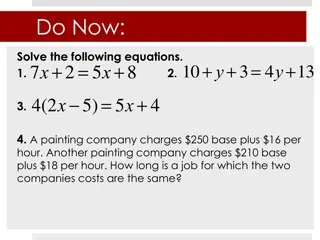Algebra Application in Pharmacy: Solving Two-Step Equations
Pharmacists indeed use algebra in their profession, involving basic algebra, fractions, percentages, and ratios to ensure accurate dosage calculations for medications. Solving for unknown variables in two-step equations is beneficial for pharmacists, as demonstrated in real-life scenarios like determining prescription quantities for different drugs. An example problem showcases how algebra helps pharmacists calculate prescription quantities effectively.
Download Presentation

Please find below an Image/Link to download the presentation.
The content on the website is provided AS IS for your information and personal use only. It may not be sold, licensed, or shared on other websites without obtaining consent from the author.If you encounter any issues during the download, it is possible that the publisher has removed the file from their server.
You are allowed to download the files provided on this website for personal or commercial use, subject to the condition that they are used lawfully. All files are the property of their respective owners.
The content on the website is provided AS IS for your information and personal use only. It may not be sold, licensed, or shared on other websites without obtaining consent from the author.
E N D
Presentation Transcript
USING ALGEBRA IN A PHARMACY Nepris Educator : Jasmin Patel
Description Solving for unknown variable(s) a in two-step equations and inequalities. Key Questions 1. I have heard pharmacists say that they use algebra in their profession. Is that true? 2. Could pharmacists use solving for unknown variables in two-step equations and inequalities in their profession? If not, what other algebra concept(s) would they use?
KEY QUESTION 1. I HAVE HEARD PHARMACISTS SAY THAT THEY USE ALGEBRA IN THEIR PROFESSION. IS THAT TRUE? Answer: Yes, It is true that algebra is used in the profession of a pharmacist. Pharmacy work involves: Basic algebra Fractions Percentages Ratios a pharmacist uses a combination of these functions to calculate the correct dosage, strength, and dilutions of the drugs and medications which they dispense to patients. Accuracy in mathematical calculations used in a pharmacy is crucial to ensuring patient safety
KEY QUESTION 2. COULD PHARMACISTS USE SOLVING FOR UNKNOWN VARIABLES IN TWO-STEP EQUATIONS AND INEQUALITIES IN THEIR PROFESSION? Answer: Yes, solving for unknown variables in two step equations is useful in a pharmacist s profession. The examples which follow demonstrate the of solving for unknown variables in two-step equations and inequalities in the pharmacist s profession as well as other real life scenarios where a pharmacist would use of Algebra
EXAMPLE: AT THE END OF THE DAY, A PHARMACIST COUNTED AND FOUND SHE HAS 4/3 AS MANY PRESCRIPTIONS FOR ANTIBIOTICS AS SHE DID FOR TRANQUILIZERS. SHE HAD 84 PRESCRIPTIONS FOR THE TWO TYPES OF DRUGS. HOW MANY PRESCRIPTIONS DID SHE HAVE FOR TRANQUILIZERS? Step 1: What are we trying to find? The number of prescriptions for tranquilizers. Step 2: Assign a variable for the number of tranquilizer prescriptions. Let s call it t. Step 3: Write down what the variable represents. Let t = number of tranquilizer prescriptions Step 4: Write an equation. We have to be careful here. The pharmacist had 4/3 as many prescriptions for antibiotics as she did for tranquilizers. Let s think about this in terms of numbers first. Suppose there were 3 tranquilizer prescriptions, 4/3 as many would mean there were 4 prescriptions for antibiotics. Or if there were 30 tranquilizer prescriptions, then 4/3 as many for antibiotics, would mean there were 40 antibiotic prescriptions. In each case, we are taking the number of tranquilizers and multiplying by 4/3 to get the number of antibiotic prescriptions.
SOLVE THE EQUATION TO FIND t (THE NUMBER OF PRESCRIPTIONS FOR TRANQUILIZERS) WHAT IS THE EQUATION TO FIND THE NUMBER OF PRESCRIPTIONS FOR TRANQUILIZERS : Let t = number of tranquilizer prescriptions So if t is the number of tranquilizer prescriptions, then 4/3tis the number of antibiotic prescriptions. We are told that together the two types of prescriptions add up to 84. CHECK YOUR ANSWER BY PLUGGING IN YOUR CALCULATED VALUE OF 36 FOR t So we end up with the equation t + 4/3t=84
PROPORTIONS Proportions will be your most used pharmacy calculation Solve most dosage calculations Numerous applications in everyday life Used when two expressions are directly related to one another Q: For instance, if 1 kg of drug cost us $5, how much would 2 kg cost? both expressions contain cost per weight A: if they are set up as ratios, once the problem is solved, both ratios should be equal
RATIO AND PROPORTION A proportion consists of two equal ratios and is essentially a statement of equality between two ratios. For example: 2 --- 5 4 = --- 10
RATIOS RATIO AND PROPORTION A ratio is the relation between like numbers or values, or a way to express a fractional part of a whole. Ratios may be written: As a fraction: 2/3 With the ratio or colon sign: 2:3 Using "per": 2 milliliters per 3 hours (2ml/3hr)
RATIOS RATIO AND PROPORTION The strength or concentration of various drugs can be expressed as a ratio. First, read the label of the drug and find the strength or concentration. Express this strength as a ratio in fractional form, as in the following examples: Tolnaftate solution : 10 mg per ml = 10 mg/1 ml (to treat skin infections such as athlete's foot, jock itch, and ringworm)
RATIO AND PROPORTION Example You have a 10-ml vial of aminophylline labeled "25 mg per ml". How many milliliters must be injected to administer a dose of 125 mg?
RATIO AND PROPORTION Example: You have a 10-ml vial of aminophylline labeled "25 mg per ml". How many milliliters must be injected to administer a dose of 125 mg? 25 mg -------- 1 ml 125 mg ----------- X ml = 25mg (X) = (1 ml) (125 mg) X = 5 ml
RATIO AND PROPORTION Example: How many milliliters must be injected from an ampule of Prochlorperazine labeled "10 mg/2 ml" in order to administer a dose of 7.5 mg?
RATIO AND PROPORTION Example. How many milliliters must be injected from an ampule of Prochlorperazine labeled "10 mg/2 ml" in order to administer a dose of 7.5 mg? 10 mg 7.5 mg = -------- 2 ml ----------- X ml 10mg (X) = (2 ml) (7.5 mg) X = 1.5 ml
RATIO AND PROPORTION Ex: A formula calls for 42 capsules of 300mg of drug. How many milligrams would be required to make 24 capsules?
RATIO AND PROPORTION A formula calls for 42 capsules of 300mg of drug. How many milligrams would be required to make 24 capsules? 300mg 42 caps = x 7,200 = 171.4 mg 42 24 caps
RATIO AND PROPORTION REAL LIFE One person's error killed Elisha Crews Bryant, hospital officials said: a miscalculation overdosed the pregnant 18-year- old with a magnesium sulfate meant to slow her labor. She got 16 grams when she should have gotten 4 grams. The young mother began having trouble breathing, went into cardiac arrest and could not be revived.
RATIO AND PROPORTION REAL LIFE Patient received 16 gms Mag. Sulfate, fatal dose. Patient should have received 4 gms. How many ML @ 25 gm/50 ml should she have received?
RATIO AND PROPORTION REAL LIFE How many ML @ 25 gm/50 ml should she have received to obtain 4 gms?? 25 gm -------- 50 ml 4 gm ----------- X ml = 25gm X = 200 gm/ml X = 8 ml
PERCENTAGE PREPARATIONS Three types of percentage preparations Percent weight-in-weight (wt/wt) X Grams / 100 Grams Percent volume-in-volume (v/v) X Milliliters / 100 Milliliters Percent weight-in-volume (wt/v)* X Grams / 100 Milliliters Most Common
PERCENTAGE PREPARATIONS Example . How much Potassium Chloride in grams is needed to prepare a 1 Liter solution of 3% KCl solution?
PERCENTAGE PREPARATIONS Example. How much Potassium Chloride in grams is needed to prepare a 1 Liter solution of 3% KCl solution? Answer: 3% = 3 grams / 100mls 1 Liter = 1000 mls Next: 3 grams ---------- X grams = ----------- 1000 mls 100 mls Finally: x = 30 grams
CONVERSIONS 6.3 oz = ? ml Arrange the units so they will cancel and solve Value x Conversion Factor x 30ml 1oz =Answer = 189 ml 6.3 oz The units of ounces cancel, and you are left with milliliters
TRY THIS ONE 1.3 kg = ? grams Value 1.3 kg x Conversion Factor x Conversion Factor =Answer x 2.2 lb x 1kg Or Approximatley 1,300 gm 454g = 1,298g 1lb
CONVERSION You receive a prescription for Cefzil 250mg/5mls with directions to take 1 teaspoonful by mouth twice daily for 10 days. How much drug in milligrams, is in one teaspoonful? How much Cefzil in milliliters do you have to give the patient to last the full 10 days?
PARENTERAL (IV) CALCULATIONS Parenteral calculations deal with administration of IV fluids Two main concepts you will learn - Flow Rate - Dose per Time
FLOW RATE CALCULATIONS Flow rate is the speed at which an IV solution is delivered Function of Volume per Time - usually reported in milliliters per hour The magical formula volume time = flow rate Always be sure which time and volume units you are being asked to solve for Is it ml/min ? Or l/hr? Something else?
FLOW RATE CALCULATIONS A patient receives 1 L of IV solution over a 3 hour period. Calculate the flow rate in ml/hr. Note: the volume given is in liters, but the answer asks for milliliters. If the conversion wasn t so obvious, we would first need to do a conversion of L ml. time = flow rate volume 1000 ml 3 hours = 333 ml/hr
ANOTHER RATE PROBLEM A patient receives 0.75L of IV solution over a 4 hour period. Calculate the flow rate in ml/hr
ANOTHER RATE PROBLEM A patient receives 0.75L of IV solution over a 4 hour period. Calculate the flow rate in ml/hr Now the conversion is a bit harder, so we do the math 1000ml = 1L 1 750ml 0.75 L x 750 ml 4 hours = 188 ml/hr
SOLVE FOR TIME By manipulating the rate formula, we can solve for time The equation becomes: volume rate = time
SOLVING FOR TIME If an IV is run at 125ml/hr, how long will 1 L last?
SOLVING FOR TIME If an IV is run at 125ml/hr, how long will 1 L last? volume rate = time 1000 ml = 8 hours 125ml/hr Milliliters cancel and you are left with the units of hours
SOLVING FOR VOLUME Play with the formula some more, and now we can solve for volume The equation becomes: rate x time = volume
SOLVING FOR VOLUME How many ml of IV solution would be required to run an IV for 12 hours at a rate of 60 ml/hr?
SOLVING FOR VOLUME How many ml of IV solution would be required to run an IV for 12 hours at a rate of 60 ml/hr? rate x time = volume IT S REALLY JUST A CONVERSION PROBLEM! 60 ml 1hr x 12 hr 1 = 720 ml
SOLVING FOR VOLUME What volume would we need to have on hand if an IV solution is to be run for 100 ml/hr for 8.3 hrs?
SOLVING FOR VOLUME What volume would we need to have on hand if an IV solution is to be run for 100 ml/hr for 8.3 hrs? 100 ml 1 hr x 8.3 hr = 830 ml























